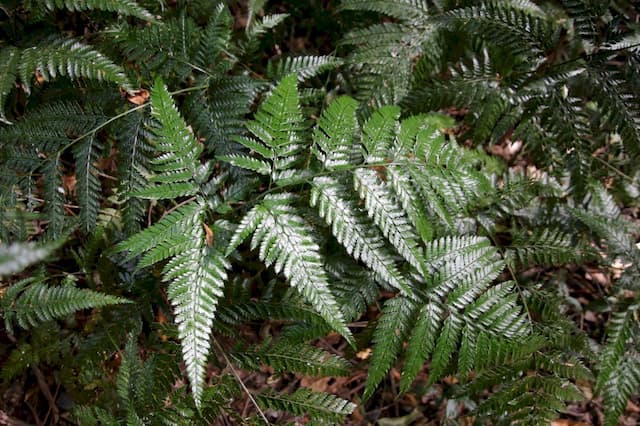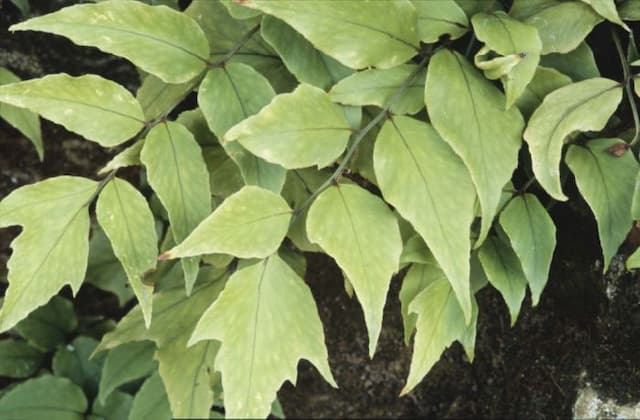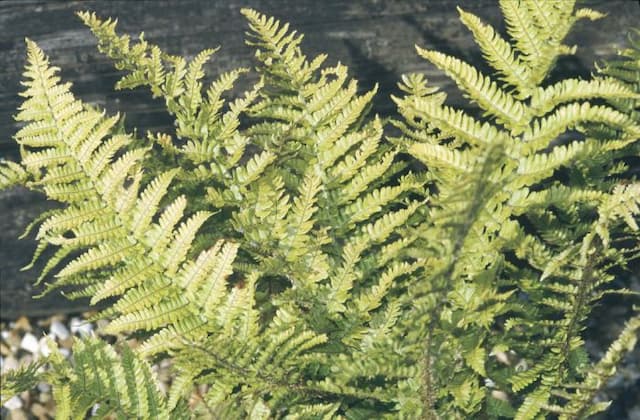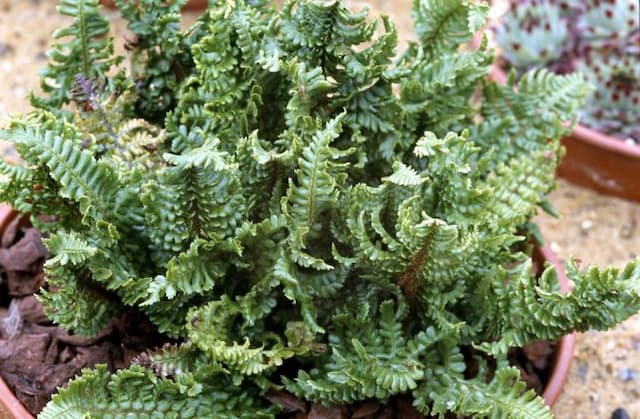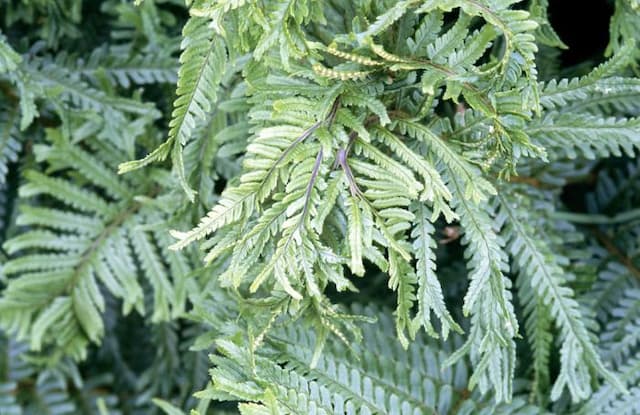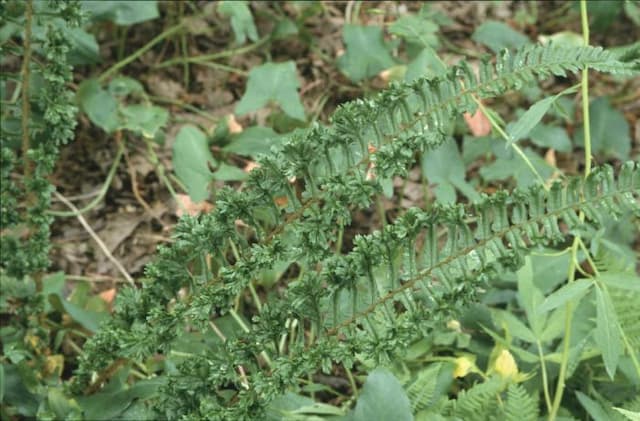Western Sword Fern Polystichum munitum

ABOUT
The common name for Polystichum munitum is western sword fern. This fern is characterized by its dark green, lustrous, lance-shaped fronds that resemble swords, contributing to its common name. Each frond is divided into numerous, neatly aligned leaflets that are pointed at the tip and have a slightly serrated or toothed margin. The overall shape of the frond is somewhat arching, giving it a graceful, flowing appearance. The leaflets have a distinct herringbone pattern, with the smaller leaflets adorning the lower part of the frond, gradually increasing in size as they approach the middle. The central ridge or stem of the frond, known as the stipe, is sturdy and has a scaly texture. These scales range in color from light brown to a pale silvery hue, adding subtle contrast against the vivid green of the leaves. The underside of the leaflets showcases rows of small, round sori, which are clusters of spore-producing structures. During the reproductive season, these sori are often covered by protective tissue called indusia, which eventually shrinks away to release the spores. Western sword fern has a thick, robust root system that supports its upright growth habit. The plant has a lush and dense demeanor, commonly thriving in forested areas where it contributes to the rich, green understory. Its evergreen nature allows the western sword fern to maintain its vibrant color and presence throughout the year, even when deciduous plants have shed their leaves.
About this plant
 Names
NamesFamily
Dryopteridaceae
Synonyms
Western Sword Fern, Sword Fern, Christmas Fern, Giant Holly Fern, Mountain Holly Fern
Common names
Aspidium aculeatum var. munitum, Aspidium munitum, Polystichum aculeatum var. munitum, Polystichum munitum var. imbricans, Polystichum munitum var. incisum.
 Toxicity
ToxicityTo humans
The common name for Polystichum munitum is Western Sword Fern. Western Sword Fern is generally not considered toxic to humans. There are no well-documented cases of poisoning from ingesting parts of this plant. It is usually regarded as non-toxic and does not typically cause symptoms if accidentally consumed in small amounts. However, it is always advisable to avoid ingesting plants that are not specifically intended for human consumption to prevent any potential gastrointestinal discomfort or allergic reactions.
To pets
Regarding the Western Sword Fern, there is no significant evidence to suggest that it is toxic to pets. Cats and dogs that ingest this fern typically do not exhibit symptoms of poisoning. It is regarded as a plant with low toxicity risk for household pets. However, individual pets may have different sensitivities, and ingestion of non-food items can sometimes lead to gastrointestinal upset. It is always best to prevent pets from eating ornamental plants as a precaution.
 Characteristics
CharacteristicsLife cycle
Perennials
Foliage type
Evergreen
Color of leaves
Green
Height
2-4 feet (0.61-1.22 meters)
Spread
2-3 feet (0.61-0.91 meters)
Plant type
Fern
Hardiness zones
4-8
Native area
North America
Benefits
 General Benefits
General Benefits- Erosion control: Western Sword Fern's extensive root system helps stabilize soil and prevent erosion on slopes and in forested areas.
- Habitat provision: It offers habitat and food for wildlife, including cover for small mammals and birds, as well as food for some species of butterflies and insects.
- Aesthetic appeal: With its lush, evergreen fronds, it is widely used in landscaping and gardens for its ornamental value, adding greenery and elegance to shady areas.
- Low maintenance: Once established, it requires minimal care, making it a convenient choice for gardeners seeking plants that do not require frequent attention or resources.
- Drought tolerance: It is relatively tolerant of drought conditions, making it suitable for gardens in regions with water scarcity once it is established.
- Cultural significance: Historically, it has cultural importance for certain Indigenous peoples who have used it for bedding and other traditional practices.
- Educational use: Commonly used in educational settings like schools and botanical gardens to teach about native plant species and their role in local ecosystems.
- Seasonal interest: Although evergreen, it adds to the seasonal dynamics of a woodland garden with changes in color and form through the seasons.
 Medical Properties
Medical PropertiesThis plant is not used for medical purposes.
 Air-purifying Qualities
Air-purifying QualitiesThis plant is not specifically known for air purifying qualities.
 Other Uses
Other Uses- Floral Arrangements: Polystichum munitum, commonly known as Western Sword Fern, fronds are often used in floral arrangements for their lush, green appearance and long-lasting freshness.
- Theme Gardens: Western Sword Fern can be a staple in themed gardens, such as prehistoric or fern gardens, due to its ancient lineage and lush foliage.
- Biodegradable Garden Mulch: The fronds can be used as a biodegradable mulch to suppress weeds and maintain soil moisture in garden beds.
- Traditional Weaving: Some indigenous cultures use the dried fronds of Western Sword Fern for traditional basket weaving and crafting other items.
- Protective Packaging: The fresh or dried fronds can serve as natural, biodegradable packaging material to protect fragile items.
- Biomonitoring: The presence and health of Western Sword Fern populations can be used as an indicator of ecosystem integrity and air quality in certain environments.
- Soil Erosion Control: The root system of Polystichum munitum helps to stabilize soil on slopes and prevent erosion.
- Frost Protection: Gardeners can use the fronds to cover sensitive plants during light frost to help protect them from damage.
- Nature Education: Western Sword Fern can be used in educational settings to teach about plant life cycles, spore reproduction, and fern ecology.
- Habitat Enhancement: This fern provides habitat for various wildlife species, including small mammals, insects, and birds that seek shelter among the dense fronds.
Interesting Facts
 Feng Shui
Feng ShuiThe Western Sword Fern is not used in Feng Shui practice.
 Zodiac Sign Compitability
Zodiac Sign CompitabilityThe Western Sword Fern is not used in astrology practice.
 Plant Symbolism
Plant Symbolism- Resilience: The Western Sword Fern (Polystichum munitum) is known for its hardiness and ability to thrive in various conditions, often symbolizing resilience and fortitude.
- Protection: With its blade-like fronds resembling swords, this fern can symbolize protection and safety, offering a metaphorical shield against negativity or harm.
- Reverence for Nature: Native American tribes consider the Western Sword Fern sacred, representing a deep respect and reverence for the natural world and its cycles.
- Endurance: The plant's evergreen nature and persistence in the wild express the idea of endurance and the ability to withstand challenges over time.
 Water
WaterThe Western sword fern should ideally be watered deeply when the soil surface feels dry, which generally means about once a week to maintain consistent soil moisture. The method should mimic natural rainfall; water at the base of the plant until the soil is saturated but not waterlogged. The amount of water needed usually translates to about 1 to 1.5 gallons for outdoor plants, ensuring the water reaches the plant's deep roots. During the hotter, drier months, it may require increased frequency of watering, but always check the soil moisture level first to avoid overwatering.
 Light
LightWestern sword ferns thrive in shady to partially shady locations, where they're protected from direct sunlight. The best spot would be an area that receives dappled sunlight or under the canopy of taller trees which provides a similar environment to their natural woodland habitat.
 Temperature
TemperatureThe Western sword fern prefers temperatures between 65°F and 75°F but can tolerate a range from just above freezing to about 95°F. These ferns are hardy and can survive in outdoor environments where winter temperatures don't typically drop below 20°F. The ideal conditions mimic their natural forest floor habitat which is cool and shaded.
 Pruning
PruningPruning Western sword ferns involves removing dead or damaged fronds to keep the plant looking tidy, which can be done any time of the year as needed. However, the best time for a more thorough pruning is in the late winter or early spring, just before new growth begins. This helps maintain the plant's natural shape and encourages healthy, vigorous growth.
 Cleaning
CleaningAs needed
 Soil
SoilThe Western Sword Fern thrives best in well-draining, loamy soil with high organic matter. A mix of two parts garden soil, one part peat moss or compost, along with some sand to improve drainage, works well. The ideal pH for this fern is slightly acidic to neutral, ranging from 5.5 to 7.0.
 Repotting
RepottingWestern Sword Ferns should be repotted every 2-3 years to prevent root crowding and replenish nutrients in the soil. They tolerate being slightly pot-bound, so repotting isn’t needed too frequently.
 Humidity & Misting
Humidity & MistingWestern Sword Ferns prefer high humidity levels, ideally around 70-80%. They thrive in environments that emulate their native woodland habitat.
 Suitable locations
Suitable locationsIndoor
Place it in a cool room with indirect light and humidify regularly.
Outdoor
Plant in shade, moist soil; winter mulch in colder zones.
Hardiness zone
3-8 USDA
 Life cycle
Life cycleThe life cycle of the Western Sword Fern (Polystichum munitum) starts with spore production; mature ferns have sori on the undersides of their fronds where spores are developed. When conditions are right, these spores are released and, if they land in a suitable environment, they germinate and grow into a tiny, heart-shaped gametophyte. This gametophyte is a haploid stage and it contains both male and female reproductive organs. It produces sperm and eggs which, upon fertilization, grow into a new diploid sporophyte — the recognizable fern plant. This young fern then undergoes growth and development, maturing into a large, pinnate frond which is the typical form of the Western Sword Fern. Throughout its lifetime, the fern goes through seasonal growth cycles, with new fronds typically unfurling in the spring.
 Propogation
PropogationPropogation time
Spring-Early Summer
Western sword fern (Polystichum munitum) is often propagated by division, which can be done in spring or early fall. The popular method involves carefully digging up an established fern and dividing the clump into smaller sections. Each section should have a portion of the root system and several fronds. New divisions should be replanted at the same soil depth they were previously growing and watered thoroughly. This method ensures new plants will have traits identical to the parent plant and can quickly establish themselves in the garden or natural area.
